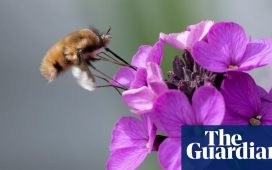The driving new moon tides of early autumn have reconfigured the seashore. In recent times the seasonally shifting sands here have made headlines: in 2018, the March stormfront we called “the beast from the east” flayed this beach down to its rocky bare bones. Today there is drenched sand all the way up to the sea wall and a rich, gently fermenting “wrack zone” of weed deposited by the morning’s high sea. It’s a last bonanza of the English summer for the swallows, who scud at waist height through an unseasonal humidity, protein-loading on kelp flies for their six-week trip to Africa.
Below where I stand at the rail of the prom one swallow clings to the concrete of the sea wall for a moment, snatching for a fly I can’t see, before launching out again with a sort of overarm flourish, like a backstroke swimmer. Further down, on the sand, two tall waders are exploring the tidal pools. Their upcurved bills – gently retroussé, without the extravagance of the avocet – tell me that they’re godwits.
Are they bar-tailed, or black-tailed? A part of me thinks, who cares? Our two godwit species are, at least, easier to tell apart than our principal kelp flies, Coelopa frigida and C pilipes (they can be distinguished from one another by the relative softness or bristliness of their leg hairs). Plumage – especially at this time of year, with everything and everyone mutable and on the move – can be misleading; it’s the shorter legs and more steeply upcurved bill that reliably give away the bar-tail.
One godwit seems to follow the other from pool to pool. With those long, probing bills, they are happier here on the sand than out on the weed-strewn rocks (where oystercatchers and turnstones, equipped with stubbier, sturdier tools, busily work over the invertebrate population).
A little further to seaward, starlings and golden plovers stage a murmuration contest, a flock-off, the starlings rising in a bold charcoal stroke over St Mary’s wetland, the plovers on the lower shore forming fluidly and noisily into a dark ribbon that crosses the sky like a contrail or a reef of cloud.







